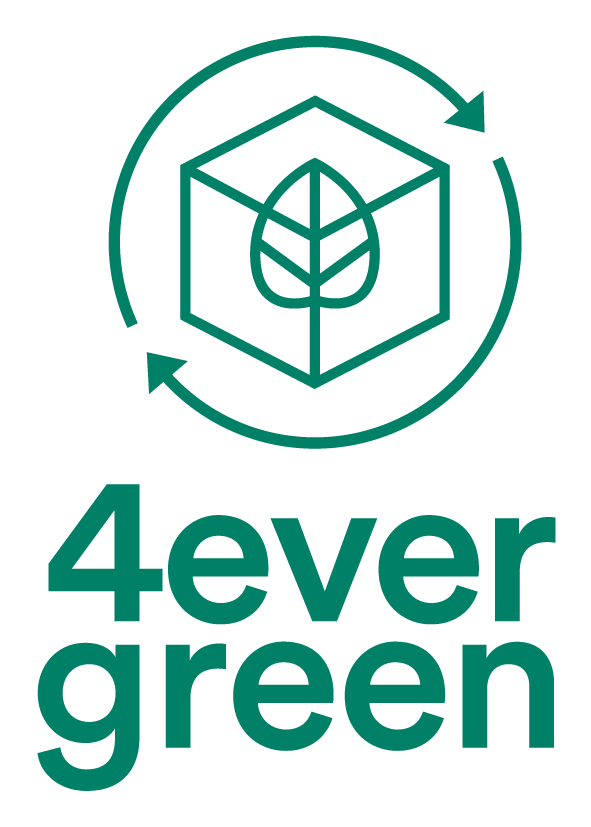P3 3-4/2021 en
4evergreen Alliance
Perfecting circularity together
Interview

As a cross-industry alliance, 4evergreen fosters synergies among companies promoting low-carbon and circular fibre-based packaging. By bringing together the entire value chain, 4evergreen enables cooperation with a comprehensive outlook on fibre-based packaging’s life cycle. P3 talked to Jori Ringman, Cepi General Director, and Hans Wortman, 4evergreen Acting Chair, about concept and goals of the alliance as well as possible difficulties.
4evergreen is a cross-industry alliance aiming to perfect the circularity of fibre-based packaging.
First things first: Alliances around the topics of sustainability and circular economy are currently en vogue and are, so to speak, “easy to sell”. What exactly is 4evergreen needed for and what are the goals of the alliance?
Hans Wortman: 4evergreen is a cross-industry alliance aiming to perfect the circularity of fibre-based packaging to contribute to a climate-neutral and sustainable society. Together with our members, we aim at raising its overall recycling rate to 90% by 2030.
Minimizing the environmental impact of this natural and renewable material by keeping it in the recycling loop is vital to reducing the impact of the industry. We are paying particular attention to packaging with a lower circularity performance today – namely the types used for household, out-of-home and on-the-go consumption.
However, there are large divergences in recycling standards across Europe, which contributes to lower recycling rates. As we began to think about how we could improve the circularity of packaging, it became clear the best way to drive innovation and find practical solutions was together. Hence why 4evergreen was created. There was a substantial need to bring all industry stakeholders from across the value chain to the table. Furthermore, the challenge of 4evergreen is to help its members think beyond their own segment – and consider the full value chain of the packaging material.
Jori Ringman: 4evergreen is unique in that it gathers the whole industry chain across Europe and beyond. Cepi has always had a tradition of working in an innovative and proactive way. However, when looking to achieve systemic change, it quickly became essential to create an alliance enabling cooperation with a comprehensive outlook on fibre-based packaging’s entire life cycle. Alone, it is impossible to achieve systemic change in circular economy. Moreover, even if we are already champions in circularity, having various perspectives from all partners in the alliance helps us identify and recognize blind spots we need to work on.
How does the cooperation between the members work?
HW: From an organizational point of view, 4evergreen is driven by the insights and initiatives of its members via four technical workstreams. Each focus on different aspects of fibre-based packaging, which a specific objective to reach. Members have the right to participate in all workstreams - they collaborate within their field of expertise to ensure the entire value chain is represented in each output delivered by the organisation. This is what brings 4evergreen at the forefront of innovation: all members, from pulp, paper and board manufacturers & recyclers, chemical suppliers, packaging producers and suppliers, Fast Moving Consumer Goods companies, food service providers & retailers, waste management companies & collectors to technology providers have discussions to align and deliver their collaborative guidelines. As a matter of fact, the work of the different 4evergreen workstreams feed into one another, making sure each set of guidelines is as comprehensive as it can be.
Is there an exchange between the members that also encompasses patents and technologies, i.e. that may come at the price of competitive advantages?
HW: Currently, 4evergreen has a dedicated workstream accelerating the development of technologies and new processes that will raise the circularity of fibre-based packaging. Its members have already initiated three projects focusing on the sorting and recycling challenges of paper and board with barrier functionality: “sortability of barrier packaging”, “novel recycling technologies” and “comparative recyclability impacts”. They aim to spur innovation across the fibre-based packaging value chain and leverage a range of novel technologies to raise fibre-based packaging’s overall recycling rate.
All in all, the workstream is a great space where members can assess comparative recyclability impacts, identify novel recycling technologies as well as test efficient new sorting technologies for barrier paper and board. We bring the members together to utilise their expertise, however, we make sure to comply with EU competition regulations at all times.
Where are the biggest hurdles in implementing the goals - in politics or in industry?
HW: 4evergreen is solution oriented. We believe a holistic approach is needed that focuses on improved design, innovative technologies and improved collection, sorting, and recycling systems - hence why the development of different set of guidelines. We would like to tackle the risk fostered by new packaging technologies, which might impose obstacles to recycling – across three critical stages of the packaging life cycle that are pre-sorting and collection, sorting and re-pulping.
On another note, we also wish the work of 4evergreen to be truly European. We would like to raise awareness about the outputs the alliance will be delivering in the second half of 2021 – indeed, our guidelines will be of great help to national industry associations and avoid duplication of work.
Our members are global, and the alliance enables the gathering of best practices in the field. We aim at making stakeholders no longer think within their silo, but about the full circle. While this perspective is new and source of compelling debates, we are gradually moving towards the same direction - truly recyclable products.
JR: The packaging market is going through substantial disruption. The pandemic, policy enactments, changes implemented by other packaging value chains, evolving economic models, innovative new materials and articles, and new ways of retailing and consuming are powerful drivers of change. Maneuvering among and leveraging these elements is the real challenge 4evergreen is tackling. Cepi and our members have been committed to working on circularity for over twenty years; 4evergreen and its key actors are now accelerating the implementation of this commitment in the industry.
Can 4evergreen act independently of Cepi or is it some sort of subdivision?
JR: A few words on the alliance’s inception: back in 2019, Cepi arranged five workshops on the Single-Use Plastics Directive’s impact for the fibre-based value chain. At the end, participants - a mixed group of industry stakeholders - agreed there was more work ahead, which resulted in the creation and start of 4evergreen in January 2020. Only such a structure can have the systemic impact needed to perfect circularity. Cepi has the unique situation that our sector integrates both fresh fibre producers and recyclers. For us it is a daily task to see there is no clash between the beginning and end of the life cycle. This is the frame where also 4evergreen acts in Cepi – we seek every opportunity to optimise the circularity performance so that at least some parts of the value chain can improve their circularity whilst safeguarding that none are worse off.
HW: Although 4evergreen is an initiative by Cepi, the alliance has enough independence to achieve the commonly agreed goals.
How do you network - and how do you reach the relevant decision-makers at European level - in order to create the necessary framework conditions?
HW: As an alliance, we strive to raise awareness in order for the industry to go forward. We support the European Union in the delivery of the Green Deal, the EU growth strategy for a circular and low-carbon future. Back in November 2020, we had the chance to welcome Virginijus Sinkevicius - EU Commissioner for Environment - at the public 4evergreen launch event. The way we help creating the regulatory conditions the sector needs is by providing guidance promoting reuse, recycling and reduce packaging waste. Ultimately, our biggest wish is for the industry to adopt our recyclability evaluation protocol and circularity by design guidelines to ensure all collected fibre-based packaging, specifically from household, out-of-home and on-the-go consumption, is recycled.
JR: We see two challenges here: the first one is to develop guidance on what would be the ideal system so that various ones across Europe can move towards that ideal system and harmonise. The second is to achieve clear labelling and marking for clearer information delivered to the consumer. Once we have a consensus on in the value chain, Cepi has access to both high political and technical level decision making in Brussels and can bring these solutions to them. Likewise, Cepi has a strong network of national associations which are ready to bring the same solutions to the national level decision makers.
Isn't there a risk that the alliance could be perceived as a pure lobbying association or at least suffer from diverging interests of the individual members?
HW: In reality, 4evergreen solely focuses on delivering technical outputs which facilitate raising the overall recycling rate of fibre-based packaging - our members work hand in hand to achieve this common goal across all segments of the value chain. The alliance’s Steering Group is the entity that provides strategic direction and oversight of its activities to ensure the coalition makes progress towards commonly defined targets and accomplishments.
JR: The alliance is not doing any lobbying at all. It is enough that the alliance members agree on the technical outputs and we trust they are then recognised as valuable and attractive solutions by policy makers as the whole society is moving towards a circular economy.
What will the future of the alliance look like and which global players would you additionally like to have on board as a member?
HW: 4evergreen would welcome any company linked to the fibre-based packaging industry committed to promoting low-carbon and circular solutions. There is a bright future for fibre-based packaging, and we need this future to be driven by a cooperative industry. This is what will enable us to move towards perfect circularity of the packaging.
JR: The joint work in the alliance is intensifying now as we have started the second year of the project. I am curious to see the discussions within the alliance towards the end of the year on what more should be achieved within this alliance. But such an extraordinary alliance where we move together to the future holding hands across the value chain can hardly be a permanent way of working. At some point we will have to conclude that we have shaped the systems and it is time to get working according to the system that emerged. Then the alliance can be concluded. What will remain, no doubt, is the understanding, willingness to cooperate and trust that has been developed during this project amongst the diverse actors across the entire value chain.
Thank you very much for the interview!









